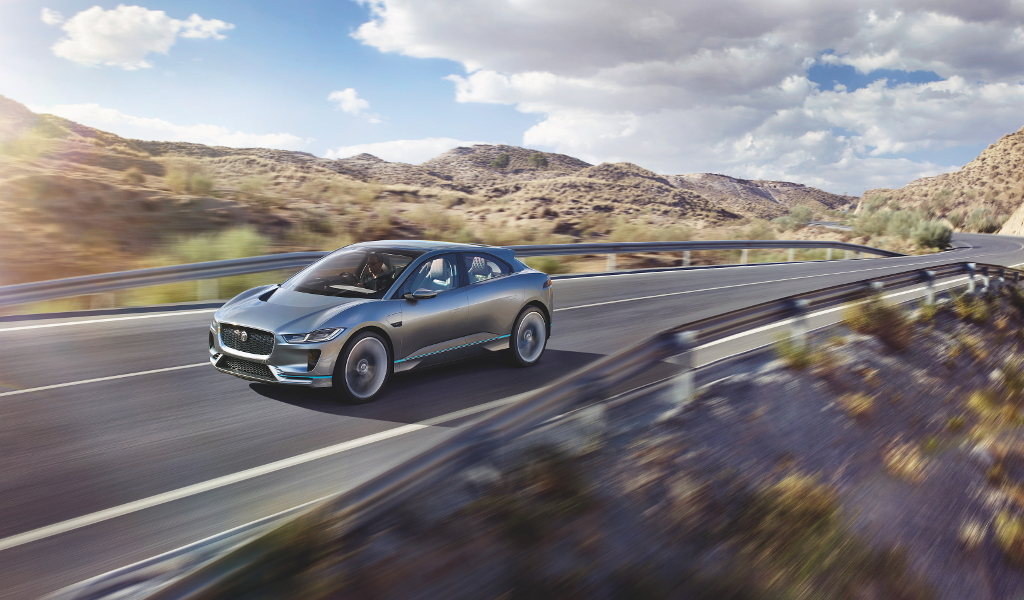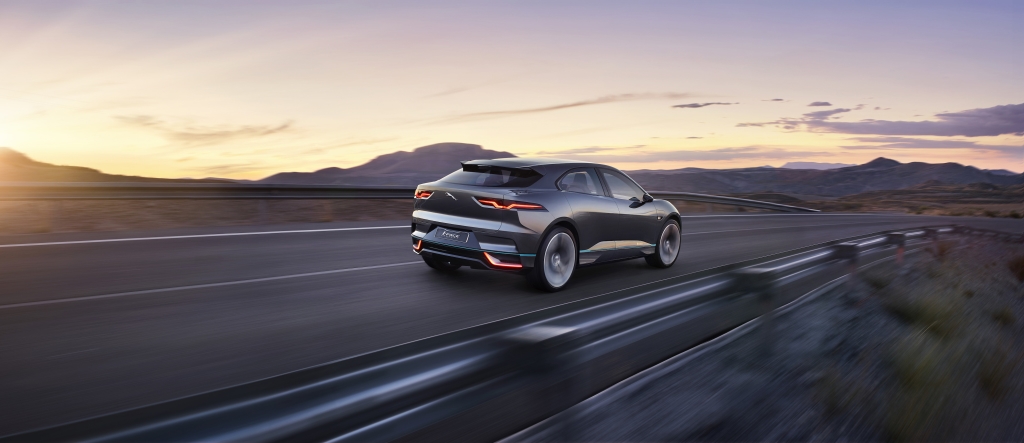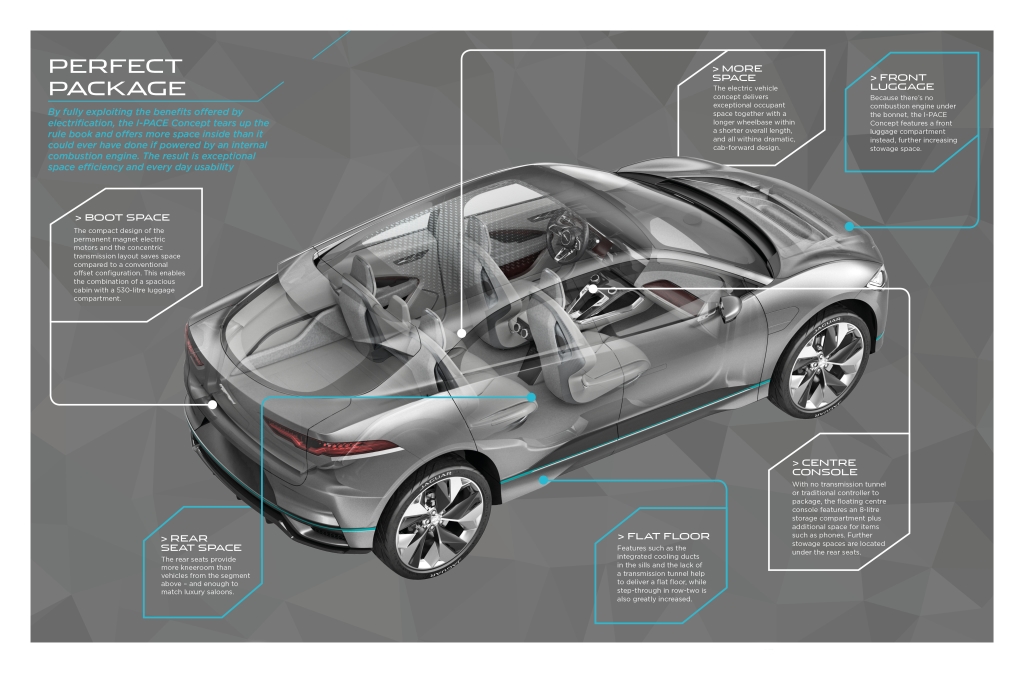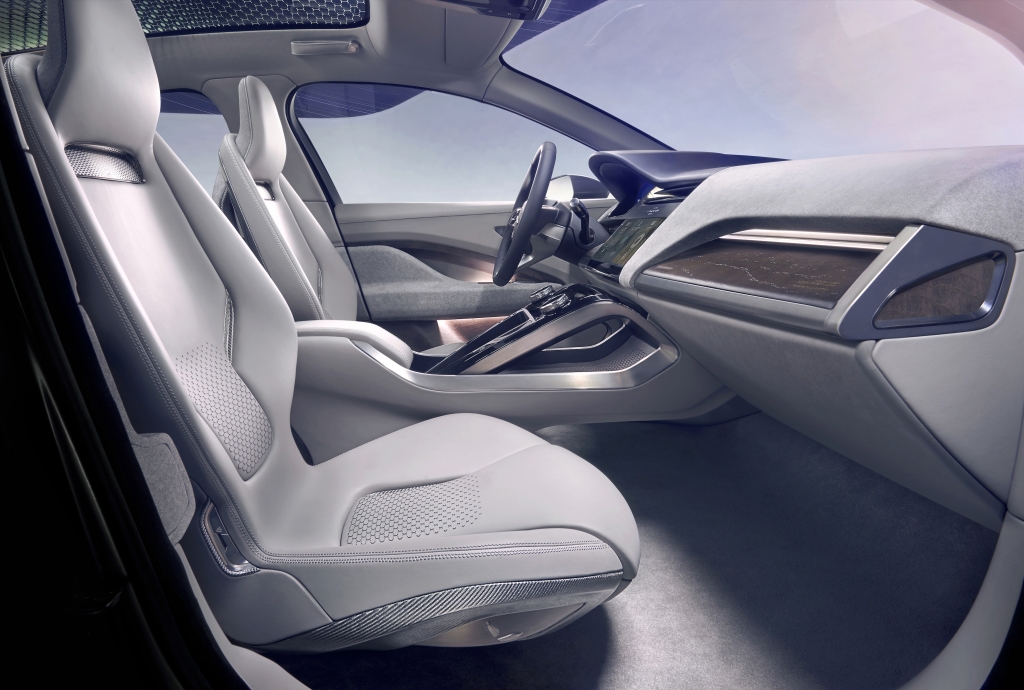After Volkswagen’s diesel debacle, there’s little doubting the electric car revolution will be reached sooner rather than later. Until now, Jaguar had stayed away from the electric debate – after the hybrid supercar concept, the C-X75, failed to get off the ground. However that’s all about to change, with the revelation of the Jaguar I-Pace – the electric performance SUV.
That last sentence is a lot to process. The notion of a performance SUV is a stupid one – compromising on weight and centre of gravity with an SUV format goes in stark contrast to the notion of a performance car. But with the success of the F-Pace (Review coming soon) – an incredible machine in its own right – and recent achievements in electric car technology, the Jaguar I-Pace may well prove us wrong…
New electric vehicle architecture…
Free from the constraints of fitting a combustion engine and transmission into a vehicle, Jaguar redesigned the basic architecture of a vehicle for the Jaguar I-Pace. Without the need for an engine bay up front, Jaguar designers and engineers were able to design a cab-forward layout with a low centre of gravity – reminiscent of the C-X75’s design.
The vehicle dynamics – despite being a 5-seater SUV – should be on point too, due to the low centre of gravity the new architecture affords. This is as a result of the flat floorpan used to install the 90kWh Lithium-ion battery back – which forms the bulk of the weight in an electric vehicle, and is housed between the Jaguar I-Pace’s 2990mm wheelbase.
If the Jaguar I-Pace is a performance SUV, how does it perform?
Let’s first look at the details behind the drivetrain. The liquid cooled, 36 module, 90kWh Li-ion battery pack is linked to two 147kW electric motors – one mounted on the front, and one mounted on the rear axle. Together, the motors develop a total output of 294kW and 700Nm.
But those aren’t a regular combustion 700Nm… No, because the Jaguar I-Pace is electric, the full 700Nm is available instantly, from the moment the throttle is applied. Combined with the AWD afforded by the 2 electric motors, the Jaguar I-Pace is capable of a 0-100km/h sprint of ‘around 4 seconds’ – highly impressive for a vehicle with an estimated weight of around 2100kg.
But that weight is distributed evenly, 50:50 front:rear or near as damnit to that, thanks to the battery pack placement. That’s just one aspect that should assist the Jaguar I-Pace in handling like Jaguars of late do…
High-tech drivetrain – what about the suspension?
The suspension on the Jaguar I-Pace is probably the least innovative aspect of the new electric SUV. Not that it isn’t advanced, it just isn’t anything we haven’t seen before.
Not a bad thing though, as the Jaguar I-Pace will adopt the same double-wishbone suspension up front as the F-Type and F-Pace, while the rear suspension is the same Integral Link setup found in the XE, XF, and F-Pace. This bodes well, as in all our recent tests of these 3 vehicles, we’ve been immensely impressed with the ride-handling balance and sheer athleticism. (Look out for our XF and F-Pace S reviews coming soon)
The front wheels will also be directed by the latest version of Jaguar’s electromechanical power assisted steering, which has been one of the best electric setups available to date.
So it can handle – hopefully – but what about ‘range anxiety’?
Range anxiety is real – don’t let anyone tell you different. There are few things more worrisome than being stuck somewhere indefinitely because Eskom couldn’t keep the electrical grid up and running.
The Jaguar I-Pace could be set to change all that though, with impressive range claims coming from Jaguar. So, how far can you expect to travel on a full charge? The bold claim is that the Jaguar I-Pace will drive ‘in excess of 500km’ on a full charge – giving it comparable range to the F-Pace V6S.
That’s calculated on the NEDC test, though, so expect 400km range in reality, and even then, electric cars are prone to fluctuations based on air temperature, so South African range may not be as favourable.
Should your range drop to a worrisome point though, there’s little to worry about. Jaguar claim the I-Pace can achieve an 80% charge in just 90 minutes, with a full charge taking just over 2 hours. That’s at present though, and Jaguar says there’s plenty room for development of their current battery technology.
Technically impressive, but what’s up with the styling?
Stunning, isn’t it? The Jaguar I-Pace has been penned by Ian Callum – the man that has been behind the design of the F-Type and F-Pace designs. Callum claims that free from the limitations of housing internal combustion components, the cab-forward design enabled him to create a coupe-like design without compromising on space or usability, whilst at the same time achieving a drag coefficient of 0.29.
The design isn’t revolutionary though, and follows on from the current Jaguar design language. In current concept form it’s truly stunning though, and the proportions look as suited to an SUV as they would to a possible 1-Series rivalling hatchback.
Callum says the Jaguar I-Pace’s design is more than just concept though – it’s just about ready for full production in 2018 with little to no changes at all.
You mentioned no compromise on space…
Yes, the Jaguar I-Pace maintains its sleek design without compromising space. The new architecture means you actually get more internal space thanks to the completely flat floor pan.
Because of the cab-forward design, the sloping tailgate has no effect on rear passenger headroom either, and the boot space is still a healthy 530 litres. But because there’s no engine up front, the Jaguar I-Pace also gets a ‘frunk’ capacity of 28-litres of storage under the ‘bonnet’.
…and the rest of the interior?
It’s all new in here, and it showcases where Jaguar intends to take the brand’s interior design. Despite the Jaguar I-Pace just being a concept, the interior seems just about production ready.
New lightweight, slimline seats are a key feature to the Jaguar I-Pace, with the electric SUV supposedly offering a lower, more driver focused seating position than any other conventional SUV. Jaguar call this the ‘Sports Command’ driving position.
The entire dash and centre console have been designed to make use of the space afforded by the flat floor, with a cantilevered centre console enabling open floor across the entire breadth of the front end of the cockpit.
The instrument panels is positioned low for enhanced visibility, and the entire dash focuses on horizontal lines and minimal switchgear. A full 12-inch digital instrument cluster is featured a-la F-Pace, and the new steering wheel features ‘hidden until lit’ switches with haptic feedback.
Without the need for a transmission tunnel, the Jaguar I-Pace utilises the centre console to house not one, but two digital touch screens. The main fully-integrated touchscreen on the upper level controls all the standard infotainment and navigation functions in a 12-inch TFT display, whilst the lower, secondary screen – measuring 5.5-inches – controls and displays all the climate control functionality, with assistance from two laser-etched aluminium rotary dials, which encase circular HD displays.
Beneath these two displays, two looping metal struts house the transmission and panoramic sunroof controls. The former sees the Jaguar I-Pace do away with a traditional gear selector in favour of push button selectors.
So when can we drive it?
The production Jaguar I-Pace will be revealed late in 2017, with it expected to arrive in South Africa in the 3rd quarter of 2018.













































